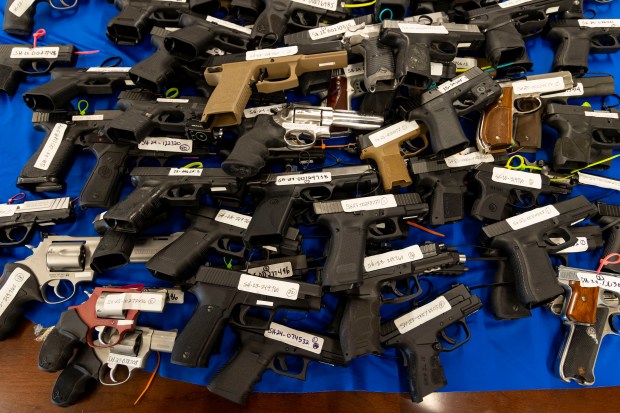Editor’s note: Regular Tribune Opinion contributor Jens Ludwig, Pritzker director of the University of Chicago Crime Lab, has a new book, “Unforgiving Places: The Unexpected Origins of American Gun Violence,” to be published April 21 by the University of Chicago Press. In this exclusive, lightly edited extract from Chapter One, Ludwig explores what caused three lives of young Chicagoans to change forever.
It was at 69th and Calumet at 10 p.m. on Halloween Eve, 1996, when Brian Willis, age 18, was arguing with Alexander Clair, 23, about a used beige two-door Ford LTD parked in front of Little Hobo’s restaurant. Clair had sold Willis the car a few days earlier and complained that Willis hadn’t paid for it yet. Willis was angry that Clair had reportedly entered the car earlier that night and tried to take it back. Regarding payment, Willis told Clair, “I’m not going to give you shit.” Regarding adherence to the transaction’s terms, Clair replied, “If I catch you in the car — if I see the car or I catch you in the car — I’m going to burn the car up.” The two argued in the street for another 10 minutes. Eventually, Willis broke off and ran across 69th, past the car and behind the building at 352 E. 69th St. Clair followed. Meanwhile Clair’s girlfriend, Jewel Washington, 25, was trailing behind when she heard two loud gunshots. Those would turn out to be the gunshots that killed Clair, fired from a short-handled, 12-gauge pump-action shotgun with one shotgun blast to Clair’s stomach and one to his head. …
Willis was later convicted of two counts of first-degree murder and sentenced to life in prison. In effect, three lives, not just two, were lost that night.
The two conventional wisdoms
For most Americans, the tragedy at 69th and Calumet in Greater Grand Crossing can be explained in one of two ways.
The first is that shootings like this one stem from characterologically bad people. Whether born bad or raised badly, the perpetrators of gun violence in this view have no moral compass or fear of the justice system. “I cannot say it any clearer — it is the good guys against the bad guys. These bad guys are violent, they carry guns, and the symbol of our public safety, which is that police uniform, they have total disregard for.” That’s from the mayor of New York City. These narratives of “bad guys” or “wicked people” are usually accompanied by calls for greater vigilance: for the government to deter or incapacitate criminals by putting more police on the streets; for the building and filling of more prisons; for private citizens to protect themselves by arming themselves.
A second perspective is that gun violence stems from root causes — that is, from a set of social conditions that fuel gun violence. In this view, violence grows where human flourishing doesn’t. “Violence is an expression of poverty” is how a recent mayor of Chicago put it. This narrative often leads to calls to fundamentally transform American society: to desegregate our cities; to end the social isolation of the most vulnerable; to take greater steps to end poverty; to dismantle the prison-industrial complex; to defund the police and the military and channel those resources back into social programs instead.
The data confirms that most Americans believe that crime and violence are due to some version of one of these two conventional wisdoms. In focus groups, Americans say crime is due to “something inherently wrong within the lawbreaker, such as lack of moral fiber, or due to ecological considerations that influence or force individuals to break the law, such as lack of money.” We see the same thing in surveys. In 1994, around the time President Bill Clinton signed the largest crime bill in U.S. history, seven of 10 Americans were telling Gallup pollsters that crime was due to amoral criminals and the failure of the criminal justice system to stop them. The next, most common explanation was poverty. Of course, these aren’t literally the only ideas out there. But they’re clearly the ones driving the conversation.
It’s not just policymakers and members of the general public who believe these conventional wisdoms. They’re what I, the person who studies crime for a living, long believed, too. I grew up reading about Ted Bundy and John Wayne Gacy and the Son of Sam killings in Time and, later, in books like “In Cold Blood” and “Helter Skelter” — violence committed by predators and lunatics. Later, as an economics major in college, I read University of Chicago economist Gary Becker’s argument that criminals are rational actors responding to incentives — that crime is a kind of market response to other, less good options. I was also reading the biographies of people like Robert Kennedy and Martin Luther King Jr. and Malcolm X, which was to read the stories of lives lost to the violence epidemic, the root causes of which these men were trying to stamp out. These two coexisting schools of conventional wisdom about what causes violence aren’t just entrenched; they’re unavoidable.
And there is indeed some truth to both ideas.
There are bad people in the world. These are people who lack empathy, are narcissists with a grandiose view of themselves, are pathological liars, have a constant need for stimulation, are manipulative, fail to feel remorse or guilt, and refuse to take responsibility for anything. Many of them show signs of problem behavior in their early years and then engage in antisocial or violent behavior for most of their lives. Some estimates suggest that perhaps 1% of all men in America fall into this group. They can be found in every walk of life: on the street corner, in a police car, teaching in a university classroom, at an investment bank or church, in a Boy Scout troop, or sometimes even in the very highest of political offices. An outsized share of these individuals wind up in prison, although most people who are incarcerated are not in this category. Psychiatrists call them psychopaths.
There is also evidence that the threat of punishment can indeed deter some criminal behaviors. We know this from studying what social scientists call natural experiments, changes out in the world that manipulate policies in a nearly random way akin to the sort of randomized controlled trial that provides gold-standard evidence in medicine. Consider the 2006 mass pardon in Italy, in which 40% of all inmates in the country were released from prison all at once. Their release came with a condition: If rearrested, people would have to serve out the remainder of their original sentence. The released prisoners varied greatly in how much time they had left on their original sentence (from one to 36 months), depending on the luck of the draw as to how far into their prison sentence they were when the pardon was issued. Thus, similar “types” of people were released facing different punishment levels for committing exactly the same crime. The data showed that those who were facing stiffer penalties engaged in less violence.
Meanwhile, the people who believe violence is borne of the persistent unfairnesses of American society, including its inequality, discrimination and segregation, are also right. Turn on the news and see where the violence happens; it’s rarely in the fancy neighborhoods.
This phenomenon is neither recent nor limited to the American context: Wherever groups of people are treated as less-than by a society, crime often follows. …
The root causes of violence, in other words, stem from both economic disadvantage and social disadvantage, including racial and ethnic discrimination. What do the consequences of this disadvantage and discrimination look like in modern-day America? They look like the five Chicago neighborhoods that together account for fewer than 1 in 10 city residents but experience fully 1 in 3 of the city’s homicides. It’s no accident that these neighborhoods are located in the most disadvantaged, socially isolated, racially segregated, predominantly Black areas of Chicago’s South and West sides. In the U.S. as a whole, Black Americans are 13% of all residents but 27% of all victims of police shootings, 33% of all prison inmates, 33% of those arrested for violent crimes and 54% of all murder victims.
The limits of conventional wisdom
The conventional wisdoms that gun violence is caused by either bad people or bad economic opportunities have produced no shortage of policy proposals. The history of these policies illustrates the limits of how we’ve traditionally characterized the problem and its solutions.
“Get tough” policies (enforcement, imprisonment, public vigilance) have helped improve safety to a degree but only by imposing tremendous harm along the way. For example, the data shows that imprisonment can reduce violence. But the growth in American prisons in the 1970s, and the harms that prisons impose on incarcerated people’s health, families and livelihoods, occurred at a rate that had no historical or international precedent. The growth in police spending has helped reduce violent crime, but the frequent gravitation toward “zero-tolerance” policing has generated substantial human costs as well. The decisions of private citizens to arm themselves has contributed to a flood of gun stores and used guns that make firearms more likely to wind up being used in crimes. All these harms are disproportionately concentrated in the same disadvantaged, segregated communities that suffer the most from gun violence itself.
Meanwhile, reforms meant to stem the root causes of violence — attempts at fixing society’s most complicated challenges through policy change — typically run aground when their political proponents reach office. Diminishing political and social returns — ideas that start from good intentions only to end in frustration and disillusion — seem to plague most attempts at addressing America’s structural problems, which remain and persist. While poverty in America has decreased by some measures, inequality in both income and wealth has increased. In Chicago, the city’s challenge with gangs shows few signs of being resolved. Racial segregation in the city has barely changed for 40 years. In the face of such minimal gains from earnest attempts to fix our biggest social problems, the reflexive “sending thoughts and prayers” approach to U.S. gun violence somehow seems less vapid: Gun violence, like racial prejudice and inequality, often appears to be the kind of problem that only wishes can solve.
The hope of many that the gun problem might be solved with a single stroke of a legislative pen — that some U.S. president and U.S. Congress will do what no previous government has done and radically reorient gun laws in America — has in practice led to few legislative victories.
Whether that will change anytime soon is far from obvious. As a 2022 New York Times headline put it, “As shootings continue, prospects for gun control action in Congress remain dim.” What has this collection of policies suggested by conventional wisdom added up to? The answer is: little long-term progress in reducing gun violence. This failure is remarkable in part because of how good the U.S. has been at addressing so many other public health problems. Since 1900, death rates per capita have declined by 38% for heart disease, 84% for strokes, 95% for respiratory diseases like influenza and pneumonia, and around 99% for tuberculosis. Overall life expectancy has nearly doubled. Yet the rate of murders, most of which are committed with guns, is almost exactly the same as it was 125 years ago.
Jens Ludwig is the Edwin A. and Betty L. Bergman distinguished service professor at the University of Chicago.
Reprinted with permission from “Unforgiving Places: The Unexpected Origins of American Gun Violence by Jens Ludwig, published by the University of Chicago Press (2025), by Jens Ludwig. All rights reserved.
Submit a letter, of no more than 400 words, to the editor here or email letters@chicagotribune.com.



